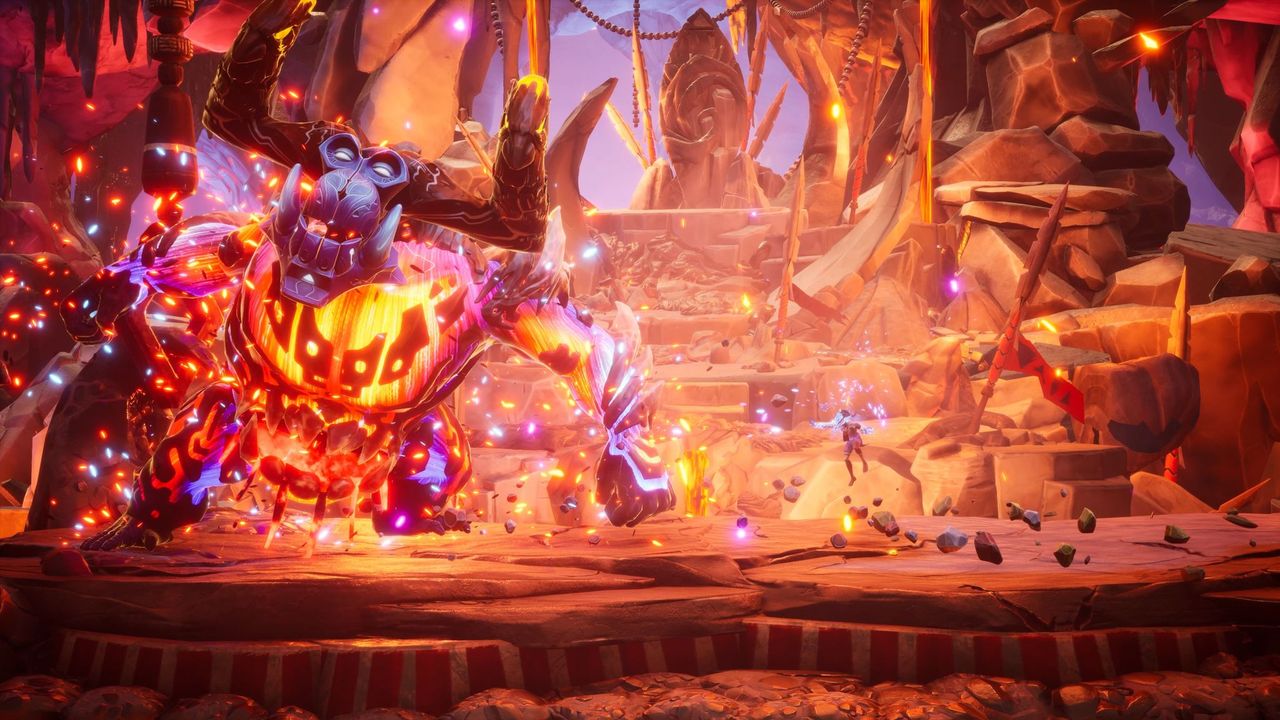
How satisfied you are with Tales of Kenzera: Zau will depend on how you’ve set your expectations going in. Surgent Studios’ debut game has been billed as a Metroidvania action-adventure title, but if you’re expecting it to deliver an experience that can rival recent genre greats like Hollow Knight or Prince of Persia: The Lost Crown, it’s likely that you’ll be left disappointed. If, however, what you’re looking for is an engaging and well-told story, Tales of Kenzera: Zau is an easy game to recommend.
Set in the mystical lands of Kenzera, Surgent Studios’ 2.5D game puts you in the shoes of Zau, a young shaman looking to revive his late father’s spirit, for which he strikes a bargain with Kalunga, the God of Death- to find the three Great Spirits who have resisted Kalunga’s calls and help them pass on from the world of the living into the realm of the dead. From that central narrative premise to how expertly it handles heavy themes like grief and loss, to the rich and vibrant world where the game is set, there’s a lot to be impressed by when it comes to virtually anything related to Tales of Kenzera: Zau’s narrative ambitions.
"If you’re expecting Tales of Kenzera: Zau to deliver an experience that can rival recent genre greats like Hollow Knight or Prince of Persia: The Lost Crown, it’s likely that you’ll be left disappointed. If, however, what you’re looking for is an engaging and well-told story, Tales of Kenzera: Zau is an easy game to recommend."
Chief among them is the deeply personal tale at the heart of the experience. Made as an homage to his own late father and the relationship he shared with him by game director and veteran voice actor Abubakar Salim (who also voices Zau in the game), themes of grief and how to deal with the loss of a loved one are always front and center in Tales of Kenzera. Each section of the game sees Zau trying to help a lingering Great Spirit move on into the realm of the dead, and each section and the unique arc it comes with ties into Zau’s own personal story in fascinating ways, often making for some genuinely moving moments.
It helps that the core cast of characters is as endearing as it is. The central duo of Zau and Kalunga are both multi-layered personalities, and both are not only well written, but also brought to life just as effectively and believably by excellent voice acting performances. The side characters you meet throughout your journey, though not nearly as prominent as Zau or Kalunga, also serve as solid additions to the cast, each bringing their own unique charms and valuable contributions to the story and its emotional core.
The setting, too, does a lot of heavylifting. Inspired by African cultures and mythologies, the lands of Kenzera are consistently gorgeous and a pleasure to simply exist in. There’s a magically atmospheric feel to the game’s world, backed by excellent visuals that, though not the most impressive from a technical perspective, benefit massively from gorgeous art design and meaningful diversity in environments. Though it’s at times a bit frustrating that Tales of Kenzera’s pared-back approach to things such as exploration don’t allow you to dive as deeply into some of the game’s environments as you’d wish (more on this in a bit), it is, at the very least, always a pleasure to simply exist and move about in the world.
"Each section of the game sees Zau trying to help a lingering Great Spirit move on into the realm of the dead, and each section and the unique arc it comes with ties into Zau’s own personal story in fascinating ways, often making for some genuinely moving moments."
Without a doubt, the story and the setting are the stars of the show in Tales of Kenzera: Zau, though when you come to its gameplay and design elements, the experience does come across as a lot more uneven. A lot of that is, of course, down to the fact that this is a story-focused game – probably much more than anything you’re used to seeing in the Metroidvania genre – which means the game’s priorities often lie with being as approachable and accessible as possible. On one hand, that comes with the obvious benefit of the game’s excellent story being easy to fully experience for as many players as possible. On the other, that also means Tales of Kenzera is frequently much more straightforward than fans of the genre would want.
At times, in fact, it’s almost easy to forget that Tales of Kenzera: Zau is, technically speaking, a Metroidvania. The labyrinthine, interconnected, backtracking-focused design that the genre is associated with is heavily pared back here, to the point where the vast majority of the game feels like a linear experience where you’re constantly progressing forward in one direction. There are definitely a few areas where you can take branching paths or try and seek out hidden secrets, challenges, collectibles, and explorable sections, but for the most part, they’re heavily de-emphasized for the bulk of the experience, which means exploration isn’t nearly as meaty or rewarding as you’d want in a Metroidvania.
Thankfully, moving through the world still feels enjoyable more often than not. Tales of Kenzera’s platforming and traversal mechanics aren’t as precise as a Hollow Knight or a Prince of Persia: The Lost Crown, nor as smooth and fluid as an Ori and the Will of the Wisps or a Metroid Dread, but within the more straightforward and pared-back structure of the experience, they do their job well enough. Chaining together jumps, double jumps, slides, and dashes while trying to navigating environmental obstacles and challenges never feels like it’s stepping outside of the tried-and-tested conventions of the genre, but though they don’t break new ground, these sections are generally fun to play through.
"At times, in fact, it’s almost easy to forget that Tales of Kenzera: Zau is, technically speaking, a Metroidvania. The labyrinthine, interconnected, backtracking-focused design that the genre is associated with is heavily pared back here."
Occasionally, however, the game can be bogged down by moments of frustration. These can come in a few forms. Movement and platforming can feels a bit sluggish and imprecise at times, which is often down to the game failing to register your inputs from time to time, seemingly at random. Certain sections also come with frustrating design decisions, from inconsistent checkpointing to sudden difficulty spikes in platforming challenges, especially with one-hit kill hazards. Though these issues remain relatively easy to forgive for the most part, they do add up in the long run, which means it does feel like Tales of Kenzera doesn’t quite hit its potential where platforming and traversal are concerned.
Combat is similarly uneven. Zau is equipped with two shaman masks that he’s inherited from his father, allowing him to wield the power of the sun and the moon, providing melee and ranged abilities respectively. You can switch between both masks on the fly, and flitting from one form to another while dodging and dashing around your enemies feels satisfying right off the bat, especially as you begin unlocking new abilities that allow you to freeze foes, throw heavy spears at them from a distance, and more.
Unfortunately, Tales of Kenzera’s combat doesn’t have enough depth to sustain itself for the entirety of the game’s runtime. Though boss fights are always unforgettable spectacles that expertly combine fast and aggressive combat with fluid platforming and plenty of visual splendour, the deeper you get into the game, the more repetitive all of its combat encounters outside of boss fights become. From lacking enemy variety to liberally repeated encounter types to paper-thin progression mechanics, Tales of Kenzera’s combat, though fun in a superficial sense, doesn’t evolve as much as it should have to meet its potential.
"Tales of Kenzera’s combat doesn’t have enough depth to sustain itself for the entirety of the game’s runtime."
Ultimately, what your takeaway from Tales of Kenzera: Zau is after you’ve rolled credits on its roughly eight-hour journey will depend on the areas you wanted the game to prioritize before diving in. Surgent Studios’ debut game excels beyond expectations in a number of areas, with a brilliantly captivating story, excellent voice acting performances, and a rich and magical setting that boasts an incredible sense of place. On the other hand, in terms of design and gameplay, the game is definitely not on the same level as the many, many modern Metroidvania greats we’ve been treated to in recent years, whether in terms of combat, platforming, or level design. Narratively, Tales of Kenzera undoubtedly succeeds in delivering on its promises, but there’s also little doubt that if it was a better Metroidvania, the entire experience could have been markedly more memorable, even if it has no shortage of unforgettable moments as it is.
This game was reviewed on the PlayStation 5.
Heartfelt, emotional story with strong thematic throughlines; A rich and magical setting that is brought to life wonderfully; A solid cast of characters, thanks in large part to excellent voice acting performances; Combat and traversal can both be fun, albeit from a superficial perspective; Looks absolutely gorgeous.
De-emphasizes exploration a bit too much; Map design feels too pared-back at times; Platforming is often let down by occasionally sluggish movement and some frustrating design decisions; Combat quickly becomes repetitive; Paper-thin progression mechanics.



















